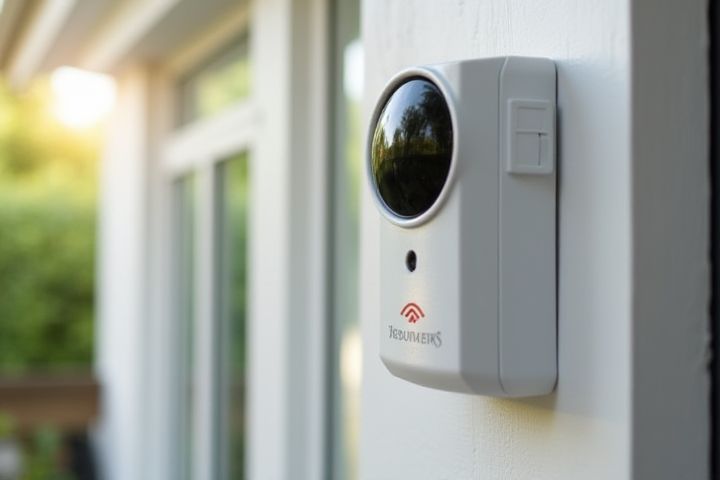
For optimal security, install house alarms at entry points such as doors and ground-floor windows, where intruders are most likely to gain access. Consider placing motion detectors in high-traffic areas, hallways, and large rooms to monitor movement throughout your home. It's crucial to position sensors at least 6 to 8 feet off the ground to avoid false alarms from pets. Outdoor alarm systems should cover driveways and garages, creating a perimeter defense. Regularly check and maintain your alarm setup to ensure it remains fully functional and responsive to potential intrusions.
Where To Install House Alarms
Main Entry Doors
Installing house alarms on main entry doors is crucial for enhancing your security. It's recommended to place sensors about 3-4 feet above the ground, ensuring they are out of reach from curious hands but still effective. When you install the alarm, position the contact sensor on the door frame and the magnet on the door itself, creating a solid connection that triggers the alarm when breached. Prioritizing your main entry points, such as the front and back doors, can significantly reduce the risk of unauthorized entries.
First-Floor Windows
First-floor windows are critical areas for installing house alarms, as they provide direct access points for potential intruders. Focus on securing double-hung, sliding, and casement windows, where intrusions are most likely. It's advisable to use window sensors that trigger an alarm when the glass is shattered or when the window is opened. For optimal effectiveness, consider placing motion detectors within 10 to 15 feet of these windows to enhance security coverage.
Back Doors
Installing house alarms on back doors significantly enhances home security, as nearly 40% of burglaries occur through this entry point. Position sensors on the frame and door, ensuring they align properly for effective operation; a slight misalignment can render them useless. It's essential to consider both wired and wireless options, with wireless systems offering flexible installation without the need for extensive drilling. Regular maintenance, including battery checks and software updates, ensures your alarm system operates optimally and keeps your home safe year-round.
Garage Access Points
When securing your home with alarms, prioritize garage access points, as they are often vulnerable entryways. Install motion sensors near garage doors and windows to detect unauthorized access, ensuring they cover all potential entry angles. Consider placing security cameras focused on the garage area to provide real-time surveillance and alerts to your smartphone. A smart lock on the door leading from the garage to your home adds an extra layer of protection, allowing you to monitor and control access remotely.
Basement Entries
When installing house alarms, prioritize locations around basement entries, as these are often vulnerable points for unauthorized access. Install motion sensors or door/window contacts on the basement door and any ground-level windows to ensure comprehensive coverage. Consider placing a keypad or control panel at the top of the basement stairs for easy access. Supplement your system with security cameras in the vicinity to monitor any suspicious activity.
Hallways
Installing house alarms in hallways is crucial for maximizing security, as these areas serve as access points to multiple rooms. Positioning motion detectors at both ends of a hallway enhances the coverage, detecting any movement effectively. Ensure that alarms are installed at an elevation of 7 to 8 feet for optimal performance, minimizing false alarms triggered by pets or objects. Strategically placing your control panel or keypad near the hallway entrance allows for quick access in emergencies, ensuring heightened safety for you and your family.
Staircases
Installing house alarms near staircases is crucial, as these areas can be high-traffic zones that lead to multiple entry points. Place motion detectors at the top and bottom of the staircase for optimal coverage, with a recommended height of 7 feet for maximum effectiveness. For stairwell landings, consider installing glass break sensors to protect against potential intrusions. Ensure all alarms are interconnected, allowing you to receive alerts in real-time, which enhances your overall home security.
Bedroom Doors
The ideal location for installing house alarms is at bedroom doors, as these access points are crucial for your safety. You should mount door sensors at a height of 3 to 4 feet, ensuring they align properly with the door frame for optimal functionality. Consider using glass break sensors for windows adjacent to the bedroom doors, enhancing your protection against intruders. With strategically placed security cameras facing these entrances, you can monitor activity and ensure peace of mind while you sleep.
Home Office Areas
For optimal security in your home office area, install house alarms near windows and doors to prevent unauthorized access. Placing motion detectors in the corners of the room enhances surveillance coverage, ensuring that any movement is promptly detected. Consider securing your network equipment, such as routers, with alarms that alert you to tampering or intrusion. Lastly, integrate your alarm system with smart home technology for real-time notifications and remote monitoring, allowing you to keep an eye on your workspace from anywhere.
Near Valuable Assets
Installing house alarms near valuable assets is crucial for enhancing security. Focus on entry points, such as front and back doors, which account for approximately 34% of break-ins. Position motion detectors around windows and garage access because these areas are often targeted, especially if they're less visible. You should also consider placing alarms near safes or valuable electronic devices, as protecting these items can deter thieves effectively.
